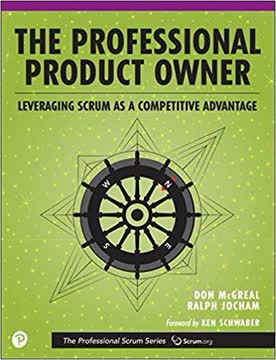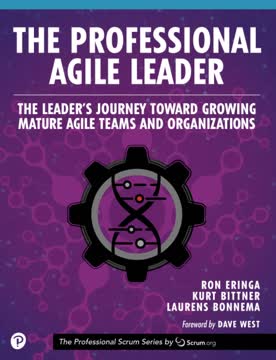Key Takeaways
1. Nexus extends Scrum to scale for multiple teams working on a single product
"Scaled Scrum is still Scrum."
Nexus basics: Nexus is a framework that enables 3-9 Scrum teams to collaborate on a single product. It preserves Scrum's core principles while adding minimal structure to manage cross-team dependencies and integration.
Key additions:
- Nexus Sprint Backlog: Coordinates work across teams
- Nexus Integration Team (NIT): Ensures product integration
- Nexus events: Refinement, Sprint Planning, Daily Scrum, Sprint Review, and Sprint Retrospective
Nexus aims to maintain Scrum's simplicity while addressing the complexities of multi-team product development. It focuses on reducing dependencies between teams and improving communication to deliver an integrated product increment every Sprint.
2. The Nexus Integration Team (NIT) is accountable for product integration
"The NIT is accountable for ensuring that the Nexus produces an Integrated Increment at least once every Sprint."
NIT composition: The NIT typically consists of the Product Owner, a Scrum Master, and representatives from each Scrum team. Members are usually part-time, balancing NIT responsibilities with their regular team duties.
NIT responsibilities:
- Facilitate cross-team collaboration
- Identify and resolve integration issues
- Coach teams on scaling practices
- Ensure the delivery of an integrated product increment
The NIT doesn't do the integration work itself but is accountable for its success. In crisis situations, the NIT may take a more active role in resolving blockers and guiding the Nexus back on track.
3. Cross-team dependencies are managed through refinement and planning
"Refinement is essential; it helps Scrum Teams work together to determine which team will deliver specific PBIs and to identify cross-dependencies across teams."
Continuous refinement: Nexus emphasizes ongoing Product Backlog refinement to minimize dependencies and create "ready" Product Backlog Items (PBIs) that can be completed by a single team.
Visualization techniques:
- Impact Mapping: Connects goals to deliverables
- Story Mapping: Visualizes user journeys and release planning
- Cross-Team Refinement Board: Identifies dependencies across teams and sprints
Nexus Sprint Planning builds on refined PBIs to create a coordinated plan across all teams. The Nexus Sprint Backlog visualizes cross-team dependencies and helps teams sequence their work effectively.
4. The Nexus Daily Scrum enhances transparency and collaboration
"The Nexus Daily Scrum makes integration issues transparent, so that the Scrum Teams can know who is responsible for fixing them."
Event sequence: The Nexus Daily Scrum occurs before individual team Daily Scrums, allowing teams to adjust their daily plans based on cross-team integration needs.
Key focuses:
- Identify integration challenges
- Coordinate cross-team efforts
- Share critical information
Attendance is flexible, with the right people attending based on current integration issues. This event promotes early problem detection and fosters collaboration across the Nexus.
5. Continuous integration and delivery are crucial for scaling Scrum
"Continuous integration without automated tests is just compilation."
CI/CD practices:
- Trunk-based development
- Automated testing (unit, integration, regression)
- Frequent builds and deployments
- Feature toggles for controlled releases
Implementing robust CI/CD practices helps Nexus teams detect integration issues early, reduce technical debt, and maintain a releasable product increment. Automation is key to managing the complexity of multi-team development.
6. Self-organization and feature teams improve productivity and flexibility
"Feature teams are cross-functional teams that are responsible for the end-to-end delivery of product features or capabilities, as guided by the Product Owner."
Benefits of feature teams:
- Reduced handoffs and dependencies
- Improved time-to-market
- Increased customer focus
- Enhanced code quality
- Stronger, more versatile developers
Transitioning from component teams to feature teams can be challenging but ultimately leads to greater flexibility and productivity. It requires an open code base, strong automation, and a commitment to cross-training team members.
7. Managing technical debt is essential for long-term success
"Dealing with technical debt is like exercise: Everyone knows they should do it, but people are often too busy to make it a part of their daily lives."
Strategies for managing technical debt:
- Include refactoring in the definition of "Done"
- Allocate a percentage of capacity to debt reduction
- Make technical debt visible on the Product Backlog
- Educate the Product Owner on the importance of addressing debt
Balancing new feature development with technical debt reduction is crucial for maintaining a healthy, sustainable product. Neglecting technical debt can lead to decreased productivity and increased risk over time.
8. Scaling the Product Owner role requires delegation and clear communication
"The Product Owner can enlist helpers or surrogates, so long as she retains the final decision authority."
Scaling strategies:
- Designate team members as Product Owner representatives
- Clearly communicate product vision and priorities
- Establish regular touchpoints with teams
- Leverage tools for asynchronous communication
As Nexus grows, the Product Owner must find ways to provide guidance and make decisions efficiently across multiple teams. Delegation helps, but maintaining a single source of product direction is crucial.
9. Scrumbling helps teams recover from integration failures
"A Scrumble occurs when a Nexus cannot deliver a fully integrated, completed increment that is done and ready for use."
Scrumbling process:
- Stop normal Sprint work
- Reduce team size to focus on core issues
- Address root causes of integration failures
- Improve development practices and environments
- Create a stable, integrated increment before resuming normal work
Scrumbling is a last resort when integration issues become overwhelming. It allows the Nexus to step back, fix fundamental problems, and establish a solid foundation for future work.
10. Transparency, trust, and Scrum values are fundamental to Nexus success
"Culture, unfortunately, is the hardest thing to change, and this can undermine any transformation."
Scrum values:
- Commitment
- Focus
- Openness
- Respect
- Courage
Building a culture of transparency and trust is essential for Nexus success. This requires consistent application of Scrum values, not just within teams but across the entire organization.
Fostering transparency and trust:
- Encourage open communication about challenges
- Celebrate examples of living Scrum values
- Use health checks to gauge team sentiments
- Establish communities of practice for knowledge sharing
Long-term Nexus success depends on creating an environment where teams feel safe to experiment, fail, and learn together.
Last updated:
Review Summary
The Nexus Framework for Scaling Scrum receives mostly positive reviews, with readers praising its practical approach to scaling agile practices. Many find it helpful for understanding and implementing Nexus, appreciating the case studies and real-world examples. Reviewers highlight its clarity in explaining how to apply Scrum principles to larger, integrated teams. Some critics note repetitiveness and a lack of depth in certain areas. Overall, readers recommend it as a valuable resource for those looking to scale Scrum, even if not specifically using Nexus.
The Professional Scrum Series Series
Similar Books








Download PDF
Download EPUB
.epub digital book format is ideal for reading ebooks on phones, tablets, and e-readers.






